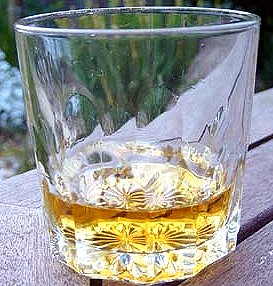Whisky
Home | Arran | Mull | Links & references
 The
word whisky comes from "uisge beatha" which is gaelic
for "the water of life".
The
word whisky comes from "uisge beatha" which is gaelic
for "the water of life".
The first written record of whisky dates back to 1494, but it wasn't until 11 years later that the Guild of Surgeon Barbers in Edinburgh were granted a charter to sell whisky.
It is believed that St Patrick originally brought the knowledge of distilling to Ireland in the 5th century A.D. from Spain and France, where the process was used to make perfume and brandy. It was later adapted to fermented mashes and cereals to produce whisky.
These early forms of whisky were produced with primitive equipment and with little scientific knowledge. As a result, many were very potent, or even harmful.
Originally, whisky was used by monks for medicinal purposes, so the methods of production were quickly passed on and soon developed into a fine art.
The ingredients of all whiskies are basically the same, consisting of barley, yeast and water. The type of barley, the preparation process, and the distillation process can all be controlled to produce a variety of end results.
However, the factor which is most difficult to change is the type of water which is used. This depends almost entirely on the naturally available water supply.
The characteristics of the water have a huge control over the quality of the spirit, and these characteristics are controlled largely by the geology of the surrounding area. The longer the water has to interact with the rocks, the more the chemistry will be altered.
If the water has fallen as rain onto impermeable, crystalline rocks, it will have little opportunity to react with the minerals, and instead, will simply run off towards the sea.
If, however the rain falls on permeable or heavily fractured bedrock, the water will percolate into and through the rock and will possibly dissolve some of the minerals which are present.
Finding a water supply with the right balance of minerals can have a crucial effect on the whisky as supplies with very little mineral content (soft water) will have a rather bland taste, whereas a water supply which may have come from deep within the bedrock may have high concentrations of minerals (hard water), and may well suffer as a result.
The whiskies produced in the South-West of Scotland tend to be more soft watered due to the amount of volcanic units in the region. They are also found to be light and smoky in taste and as a result are very drinkable. An excellent example is Laphroaig, which has been produced on the coast of Islay since 1815.
Try these links for more information on whisky: